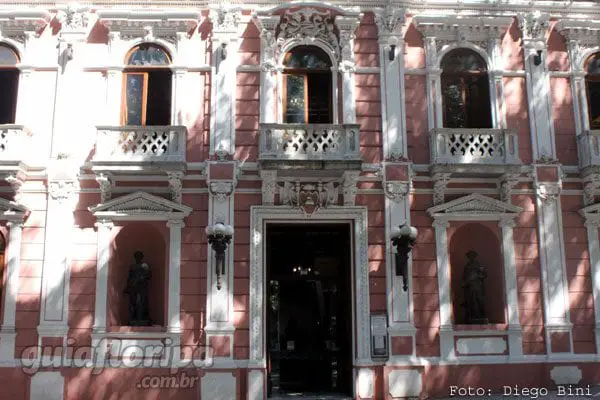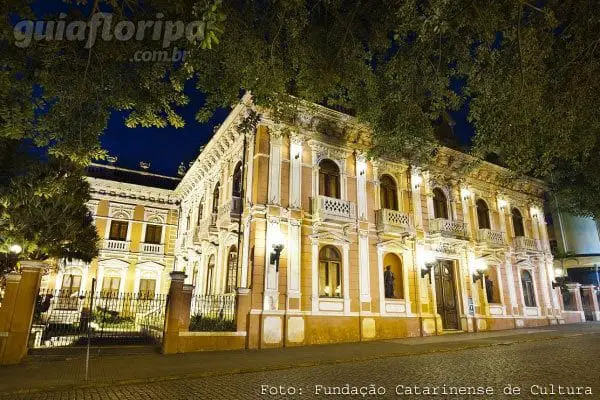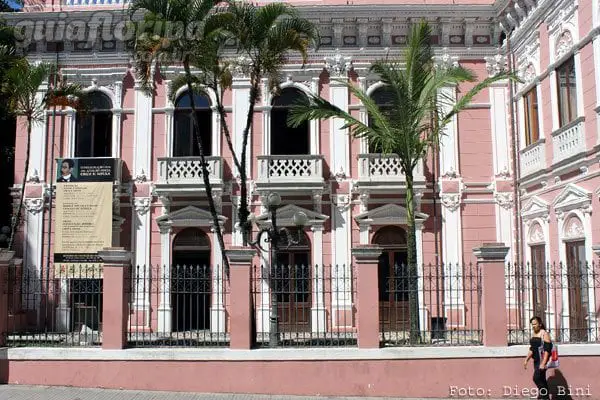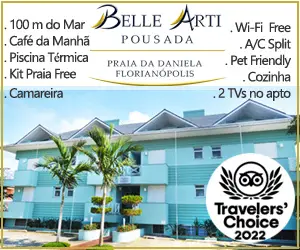The colonial townhouse was built by Governor Brigadeiro José da Silva Paes with the aim of making it the State Government Palace. It is currently the Historical Museum of Santa Catarina Palácio Cruz e Sousa.
The exact date of construction is unknown, but there are records of the building in the year of 1785.

The Palace, located in the heart of the city, opposite the XV de Novembro Square and next to Metropolitan Cathedral of Florianópolis, was the scene of several solemnities and political and military events, including visits by the Brazilian emperors Dom Pedro I and Dom Pedro II. The “Palácio Rosado” was the birthplace of Afonso Escragnolle Taunay, son of the then president of the province, the Viscount of Taunay.
Aderbal Ramos da Silva was also born in the Palace, and later became one of the governors of the state of Santa Catarina.
ADVERTISING
From the Colonial Mansion to the Museum
The government house has not always kept the same architecture. In the construction, Portuguese and Azorean details were visible and the color of the building was white, which denoted the simplicity of colonialism. In 1785, the building was divided into three sections and two floors.
In the 1977th century, the house gained a modern look and lost the simplicity of a big house. Expanded in 1979, the art of neoclassicism is added. In XNUMX, the building was renamed Cruz e Sousa Palace, a tribute to the Santa Catarina poet of the same name. Five years later, the Palace is listed as a Historic Heritage of Santa Catarina and undergoes a new restoration.
In 1986, the site is reopened and becomes the Historical Museum of Santa Catarina Palácio Cruz e Sousa.

Current overview
In 2005, restoration work began on the decorative paintings of the interior walls and stucco ceilings. At the entrance of the palace, the visitor can observe three marble statues: the main one symbolizes the Brazilian federation, the others, Europe and Latin America.
Carrara marble staircases lead to the second floor and connote the clarity, balance and measure of classical antiquity. A tribute on the ceiling above the stairs is made to the oldest municipalities in Florianópolis, flowerings with the names of Hut, St. Joseph e Santo amaro da imperatriz they're there.
ADVERTISING
The will of each inhabitant who lived in the palace brought different styles to the residence, which gained skylights on the roof, plaster designs in each room, marquetry with Azorean influence on the floors, each with specific symbolisms: in the music room, angels with sheet music and instruments. In the dining room, fruits and flowers. In the noble hall, state weapons.
In addition to bronze statues that allude to Freemasonry, agriculture and industry. The white color came out and the Pink Palace, as it is known, gained the tone that has prevailed to this day. Thus, eclecticism is the best way to define architecture at the Santa Catarina Historical Museum.
Currently, the old palace also houses the centenary Historical and Geographical Institute of Santa Catarina. In the room Martin of Haro, launches and exhibitions on art and history take place.

Memorial in the Garden
The main entrance to the Santa Catarina Historical Museum is through Rua Tenente Silveira, the blasted glass doors with the Museum's name lead to the stairs, and then to a garden. There, a memorial to the poet Cruz e Sousa was also inaugurated on May 6, 2010. The mortal remains are deposited on a tombstone on the wall of the space designed to house a future café. All documentation on his biography is in a room in the museum's entrance hall.
Objects
Furniture in the style of D. João V, the copy of the painting of the First Mass in Brazil, by Victor Meirelles, violin, piano, a German art nouveau music box and the first residential electric lamp in Santa Catarina are some of the pieces featured in the Museum.
There is only one rule: on the second floor, visitors are invited to put on a slipper, a measure adopted to protect and preserve the old floor.
Symbolist Poet Cruz e Sousa
Birth name is João da Cruz e Souza, he was born on November 24, 1861, in the former Desterro. His father was a slave and his mother was freed. He lived in the house of Marechal Guilherme Xavier de Sousa, where he received an exemplary education, which together with the thinking and abolitionist mind transformed the trajectory of his own life. He is classified as an icon of Symbolism.
He got to know many places in Brazil working with theater companies. He served as the director of a newspaper, where he published abolitionist articles. Prejudice and discrimination prevented the poet from participating in literary circles of the time.
He married and had four children. All died of tuberculosis, the oldest still reached the age of 17. The poet from Santa Catarina died in 1898, in poverty, and the cause of death was also tuberculosis. Each passage of the artist's poems brings sounds that arouse intense emotions in the reader.
Incarnation
Carnal, let so many desires be carnal,
carnal, be carnal so many desires,
palpitations and shudders and twitches,
from the harps of emotion so many arpeggios...
Dreams, which go, by trembling flutters,
at night, in the moonlight, swelling the breasts
dairy products, with fine and bluish veins
of virginity, of modesty, of shame...
Cruz e Souza
ADVERTISING
Cruz e Sousa Palace - Residence and Command
1747 - Brigadier José da Silva Paes. First governor of the Captaincy of Santa Catarina. He even sends a letter to the King of Portugal asking for the construction of the Government Palace.
1821 - The system changes, the provinces are the new forms of government in the imperial period.
1823 - The first president of the province is Antônio Rodrigues de Carvalho, whose deputy is Floriano Peixoto.
1889 - Proclamation of the Republic.
1895 to 1898 - Management of Hercílio Luz.
1898 - Death of the poet Cruz e Sousa.
1954 - Palácio dos Despachos - The address of the governors is transferred to the Casa da Agronomica, but the Palace is specific for command.
1977 - The first restoration is carried out and the Santa Catarina Historical Museum is created.
1979 - The building is named Palácio Cruz e Sousa in honor of the poet from Santa Catarina.
1984 - The museum is listed as a historic patrimony of Santa Catarina and new restorations are starting.
1986 - The Palace is reopened after restorations.
2005 - The building undergoes new repairs and restorations.
2007 - The Museum receives the remains of Cruz e Sousa.
2010 – Inauguration of the Memorial in the Garden to the poet Cruz e Sousa.
Address, Visitation and Contact
Santa Catarina Historical Museum - MHSC based at Palácio Cruz e Sousa - XV de Novembro Square, 227 - Centro.
Tuesday to Friday, 9 am to 17 pm (Gate opening times remain the same: 10 am to 18 pm). Saturdays, Sundays and holidays, from 10 am to 16 pm.
R$ 5. Students and teachers from private schools pay R$ 2. Free, upon proof, for children up to 5 years old, students and teachers from the public school system (municipal, state and federal), Brazilians over 60 years old and tour guides. On Sundays, admission is free for everyone.
(48) 3665-6363 or at Catarinense Cultural Foundation website.
Santa Catarina Historical Museum - Cruz e Sousa Palace

Santa Catarina Historical Museum Cruz e Sousa Palace | Museum in Florianópolis Visitation and Contact: - Tuesday to Friday, from 9 am to 17 pm (The gates open from 10 am to 18 pm).- Saturdays, Sundays and holidays, from 10 am to 16 pm. Admission R$ 5.- Students and teachers from private schools pay R$ 2.- Free, upon proof, for children up to 5 years old, students and teachers from public schools (municipal, ... [See more]
Theater of the Historical Museum of Santa Catarina - Cruz e Sousa Palace
Santa Catarina Historical Museum - Cruz e Sousa Palace | Theater in Florianópolis Theater with capacity for 60 people




